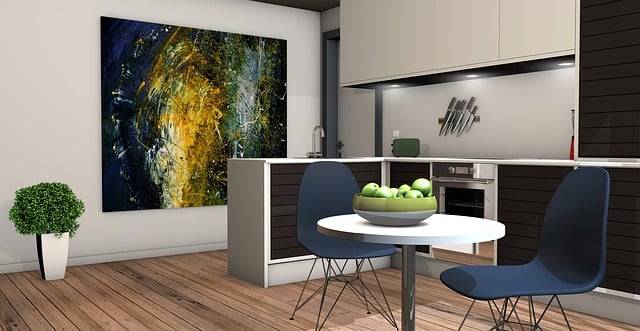Butcher block countertops are renowned for their combination of practicality and aesthetic value, offering various wood types like oak, maple, or walnut with visible grain patterns. Highly durable, scratch-resistant, heat-resistant, and easy to maintain, they are suitable for both residential and commercial kitchens prioritizing hygiene. Installation requires thorough preparation, accurate measuring, cutting, shaping, and sealing. Proper care involves regular cleaning, prompt spill blotting, occasional vinegar washes, and annual resealing to preserve their beauty and longevity.
Looking to transform your kitchen with a professional touch? Butcher block countertops are a popular choice for their natural beauty and durability. This comprehensive guide delves into the entire process of installing and finishing these versatile surfaces. From understanding different styles and benefits of butcher block to preparing your space, step-by-step installation instructions, and expert care tips – we’ve got you covered. Elevate your kitchen with the perfect finish!
- Choosing Butcher Block Countertops: Styles and Benefits
- Preparation and Site Readiness for Installation
- The Installation Process: Step-by-Step Guide
- Finishing Touches: Sealing, Maintenance, and Care Tips
Choosing Butcher Block Countertops: Styles and Benefits
Butcher block countertops are a popular choice for both professional and residential kitchens, offering a unique blend of functionality and aesthetic appeal. When it comes to styles, butcher blocks come in various wood species such as oak, maple, or walnut, each exuding its own natural charm. The classic look features a smooth, flat surface with visible grain patterns, adding warmth and character to any space. These countertops are particularly favored for their versatility; they can be customized with different finishes, stains, or even personalized edge profiles to match specific design preferences.
Beyond aesthetics, butcher block countertops offer numerous benefits for professionals. They are highly durable and resistant to scratches and chips, making them ideal for high-traffic areas and commercial kitchens. The solid wood construction provides excellent heat resistance, allowing for direct contact with hot pans without damaging the surface. Moreover, butcher blocks are easy to clean and maintain, as they do not absorb liquids or harbor bacteria. This makes them a practical choice for food preparation areas where hygiene is paramount.
Preparation and Site Readiness for Installation
Before professional installation begins, thorough preparation and site readiness are essential for successful butcher block countertop installation. This includes clearing the workspace, ensuring proper measurements, and verifying that the surface is clean, dry, and free from debris or existing residue. All necessary tools and materials should be on hand, including the butcher block itself, silicone caulk, a level, measuring tape, and any hardware required for installation.
Proper site preparation involves checking beneath the countertop area for plumbing and electrical components to ensure safe and secure placement. Any potential obstacles or issues discovered during this phase should be addressed beforehand to avoid delays or complications later in the process. Additionally, verifying that the subfloor is level and stable is crucial for long-lasting countertop integrity.
The Installation Process: Step-by-Step Guide
The installation process for butcher block countertops involves several careful steps to ensure a durable and aesthetically pleasing finish. It begins with measuring and preparing the surface, ensuring it’s clean and level. The countertop material is then cut to size, requiring precise measurements and a sharp blade to maintain the integrity of the wood. After cutting, the edges are shaped and smoothed for a finished look.
Next, the countertop is fitted onto the surface, using either an adhesive or mechanical fastening method, depending on the specific installation requirements. Any gaps are filled with caulk for a seamless finish. The final step involves sanding and sealing the wood to protect it from moisture and enhance its natural beauty. This meticulous process transforms raw materials into stunning butcher block countertops, adding both functionality and style to any kitchen or workspace.
Finishing Touches: Sealing, Maintenance, and Care Tips
When it comes to finishing touches for butcher block countertops, sealing is a crucial step that should not be overlooked. A good sealant creates a protective barrier against moisture, stains, and bacteria, ensuring your countertop remains in pristine condition for years to come. Look for food-safe sealants designed specifically for butcher blocks, as these will offer the best protection without introducing harmful chemicals into your kitchen environment. Regular maintenance involves routine cleaning with mild soap and water, followed by a quick wipe down with a dry cloth. Avoid using abrasive cleaners or harsh scrubbers, as they can damage the surface.
Proper care extends beyond daily cleaning. Always blot up spills immediately to prevent water damage, which can lead to warping over time. For stubborn stains, use a mild vinegar and water solution, gently rubbing with a soft cloth. Annual resealing is recommended to maintain the integrity of your butcher block countertop. By following these simple maintenance and care tips, you’ll preserve the beauty and longevity of your investment, ensuring it remains a functional and stylish centerpiece in your kitchen for years to come.
Butcher block countertops offer a timeless and versatile choice for any kitchen. From selection to installation and maintenance, understanding each step ensures a beautiful and durable finish. By following the guide on choosing the right style, preparing your space, installing with precision, and applying expert sealing techniques, you’ll create a stunning centerpiece that elevates your culinary experiences for years to come.
